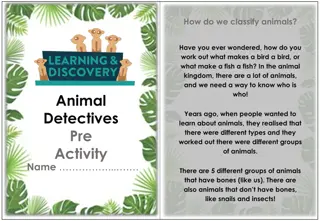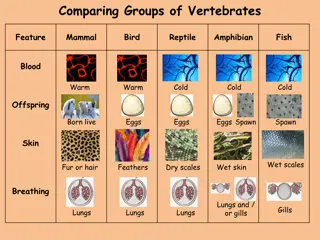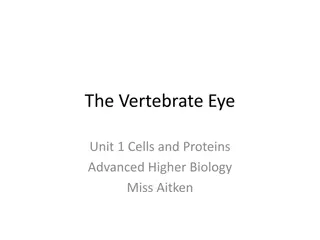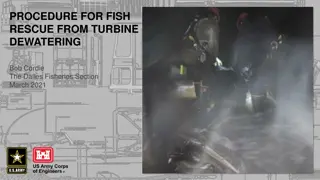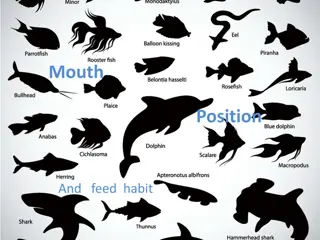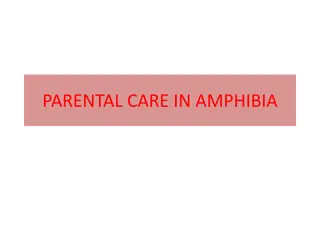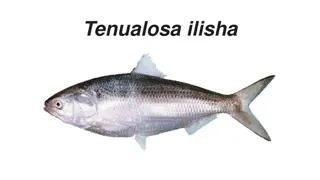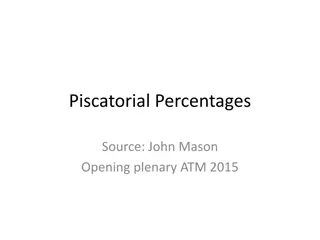Comparative Analysis of Vertebrate Brains: From Cartilaginous Fish to Amphibians
The brain in vertebrates varies in size and complexity, with distinct structures like the prosencephalon and mesencephalon. From cartilaginous fishes with large olfactory lobes to bony fishes with specialized brains, the evolution of brain structures can be observed. Amphibians, like frogs, show unique contrasts in brain anatomy compared to other vertebrates, with differences in the sizes of olfactory and optic lobes.
Download Presentation

Please find below an Image/Link to download the presentation.
The content on the website is provided AS IS for your information and personal use only. It may not be sold, licensed, or shared on other websites without obtaining consent from the author.If you encounter any issues during the download, it is possible that the publisher has removed the file from their server.
You are allowed to download the files provided on this website for personal or commercial use, subject to the condition that they are used lawfully. All files are the property of their respective owners.
The content on the website is provided AS IS for your information and personal use only. It may not be sold, licensed, or shared on other websites without obtaining consent from the author.
E N D
Presentation Transcript
(Nervous system) Unit 7 (Nervous system) Unit 7 Comparative Account of Brain in Vertebrates Comparative Account of Brain in Vertebrates Class name IILS Course name - LS-Chordates (Rohit)
Introduction 1. Brain is the organ of soft nervous tissue contained in the skull of vertebrates functioning as the coordinating centre of the body. 2. The anterior end of embryonic neural tube forms embryonic brain which is known as encephalon. 3. Adult Brain is differentiated into 3 parts:- Prosencephalon (forebrain) Mesencephalon (Midbrain) Rhombencephalon (Hindbrain) 3. Adult Brain has a series of cavities called Ventricles. 4. These ventricles remain in continuation with ventral canal of the spinal cord and filled with a cerebro-spinal fluid.
5. Out-pocketing of the anterior end of the forebrain forms telencephalon. 6. Telencephalon forms cerebral hemisphere . 7. Antero-ventral part of telencephalon grows and differentiated into olfactory lobe or rhinencephalon. 8. From the mid brain, a outgrowth called optic lobes forms. 9. Similarly median outpocketing of the hind brain forms metencephalon 10. Metencephalon differentiates into the cerebellum. 11. Remaining hind brain develops into medulla oblongata which remains continuous with the spinal cord.
Pattern of generalised vertebrate brain. (Left to right; Lateral view/Dorsal view and Ventricles.)
Comparative account Cartilaginous Fishes:- In Elasmobranch fishes (Shark or Dog fishes), olfactory organs are enormous so that olfactory lobes of brain are large. Olfactory lobe attach to cerebrum by short and stout olfactory tract. Optic lobes are relatively moderate in size. Mid brain (third venricle) is quite large and extended into optic lobes. Cerebellum is large due to active swimming habit.
Brain of Scoliodon A. Dorsal view B. Ventral view C. Venricles
Osteichthyes In bony fishes, brain is more specialised than elasmobranchs. When Perch (Bony fish) brain is compared to shark, it was reported that cerebral hemispheres and diencephalon are smaller. Moreover, Optic lobe and cerebellum are larger.
Amphibians Frog brain shows many contrast in comparison to dog fish. Olfactory lobes smaller Optic lobes larger Floor of cerebrum receives greater number of sensory fibres- projected from thalamus than in fishes. Two cerebral hemisphere shows greater development with more complex activities of locomotion, hibernation, breeding etc. Mid-brain reduce the lumen into narrow passage called aqueduct. Poor development of cerebellum Medulla small
Reptiles Live terrestrial mode of life So there is advancement in size and proportions of brain. Two long olfactory lobes are connected to cerebral hemisphere which are larger than in amphibians. Vomeronasal nerve from the organ of Jacobson goes to the olfactory bulbs. III venricle is reduced to a narrow cerebral aqueduct. Cerebellum relatively larger
Birds Olfactory lobes small Both cerebral hemisphere are larger III ventricle is also narrow Cerebellum enlarged with superficial folds due to many activities muscular coordination and equilibrium such as flight is greatly several like
Mammals Brain is proportionately larger than other vertebrates Cerebral hemisphere of prototheria are smaller like retiles but larger in metatheria. Cerebral hemispheres of Eutheria become greatly enlarged and divided into lobes. Its surface is convoluted with a number of elevations separated by furrows. This folding increases gray matter containing nerve cells resulting in greater intelligence without adding to the size of brain. Two cerebral hemispheres are joined together by transverse band of fibres called Corpus callosum. Olfactory lobes are relatively small.
Cerebral aqueduct is present Cerebellum is also large enough to cover both midbrain and medulla. Hindbrain contains centres for the regulation of digestion, respiration and circulation. Diencephalon and midbrain are completely covered by cerebral hemispheres. Characteristics of mammals are presence of 4 solid optic lobes called Corpora quadrigemina



